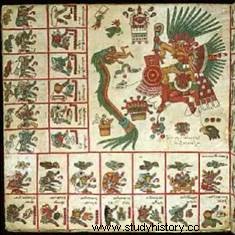 It's from the 3rd century AD, and more from the 10th century , that the great pre-Columbian civilizations were born (before the arrival of Christopher Columbus ). The best known are the Mayas, Toltecs, Aztecs and Incas. Drawing their power from agriculture and endowed with developed political and religious structures, these civilizations each in their own way established great empires. The archaeological traces they have left are important:Palenque, Tikal and Chichén Itzá, Monte Albán or even Machu Picchu. As brilliant as their art was, these pre-Columbian civilizations proved to be fragile, due to a lack of technical knowledge and real metallurgy. They did not resist the onslaught of Europeans who landed on the continent from the 16th century.
It's from the 3rd century AD, and more from the 10th century , that the great pre-Columbian civilizations were born (before the arrival of Christopher Columbus ). The best known are the Mayas, Toltecs, Aztecs and Incas. Drawing their power from agriculture and endowed with developed political and religious structures, these civilizations each in their own way established great empires. The archaeological traces they have left are important:Palenque, Tikal and Chichén Itzá, Monte Albán or even Machu Picchu. As brilliant as their art was, these pre-Columbian civilizations proved to be fragile, due to a lack of technical knowledge and real metallurgy. They did not resist the onslaught of Europeans who landed on the continent from the 16th century.
The problem of sources on pre-Columbian civilizations
If any historian depends on his sources, the problem is very real when it comes to the history of the Americas before the conquest. The main sources come from the Spaniards, who based themselves on the oral testimonies of the populations, and we therefore understand the questions that this raises. In addition, Aboriginal peoples have a notion of circular time, far removed from that of Europeans.
Another possible source, which has raised many questions in history, is archaeology. But in the American case, it is fragmented and difficult to interpret. It is in fact only in Mesoamerica that the difficulties are significantly less thanks to the existence of calendars and writing. The problem that arises, however, is the mixture in these sources between history and myth. The same goes for the history of dynasties, as the units of time differ so much.
A large and dispersed population
We know today that the Amerindian peoples are not strictly speaking "indigenous", since they came from Asia around 30,000 years ago.
The debates mainly concern the population figure, since the ranges have long varied according to historians between 100 and 10 million! According to a recent study by William M. Denevan (1992), the American continent as a whole would have welcomed on the eve of the conquest a little more than 50 million inhabitants, including 4 million for North America and 14 million for only Mexico. The characteristic of this population is its great dispersion, with a high density first in the Pacific zone, then in the Atlantic zone, while the great plains, for example, seemed very "empty".
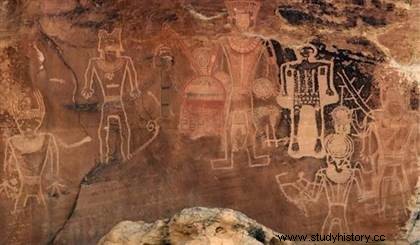 Thanks to the study of archaeological sites, we know that these populations lived in dense villages. A part was also nomadic, mainly in North America. In the 15th century, for example, the Inuit migrated eastward to Greenland.
Thanks to the study of archaeological sites, we know that these populations lived in dense villages. A part was also nomadic, mainly in North America. In the 15th century, for example, the Inuit migrated eastward to Greenland.
North America
This is what we call what has become Canada and the United States. It was the linguists of the 19th century who identified the languages and dialects, and allowed a classification into twelve large groups allowing us to see the mobility of the tribes and the ethnic mixing. The major geo-cultural areas in which these groups can be located are generally:the wooded northeast (with, for example, the Algonquian and Iroquoian families), the southeast (Cherokees, Seminoles), the arid southwest ( first the Hopi, then the Apaches and the Navajos), the Great Plains (the Sioux, the Blackfeet or the Cheyenne), the plateaus of the Rocky Mountains (Paiutes, Nez-Percés), the Pacific coast (Yuroks, Tlingits, Nootkas) , and arctic regions (Inuits, Aleuts).
This list is not exhaustive, but gives an idea of the different groups encountered by the conquerors, and the links between them. Similarly, if we know part of the functioning of these very diverse societies (and not all nomadic), it is much more difficult to make their "history" before the conquest than for the Mesoamerican or Andean peoples, for lack of sources. There are only a few examples of political constructions at the end of the 15th century, such as the meeting of the Iroquois tribes in Ontario, which led to the creation of a quasi-democratic system, which would have its importance in the 17th century.
“Disappeared” Mayans?
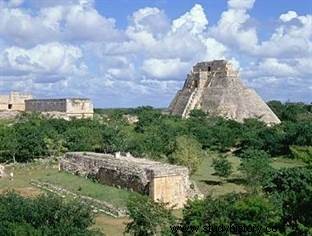 The fall of the great Maya cities of the so-called classic period (generally between 300 and 900 AD) still provokes many fantasies today, sometimes giving the impression that the Mayan civilization itself had almost disappeared with the arrival of the conquistadores! Obviously, this is not the case, and if the main Mayan sites have been deserted, there are still a few, such as Mayapan, which succeeds Chichén Itza defeated in the first half of the 13th century. The population of Mayapan is estimated at more than 10,000 inhabitants on the eve of the conquest, although it too was finally abandoned shortly before the arrival of the Spaniards (probably around 1440).
The fall of the great Maya cities of the so-called classic period (generally between 300 and 900 AD) still provokes many fantasies today, sometimes giving the impression that the Mayan civilization itself had almost disappeared with the arrival of the conquistadores! Obviously, this is not the case, and if the main Mayan sites have been deserted, there are still a few, such as Mayapan, which succeeds Chichén Itza defeated in the first half of the 13th century. The population of Mayapan is estimated at more than 10,000 inhabitants on the eve of the conquest, although it too was finally abandoned shortly before the arrival of the Spaniards (probably around 1440).
The situation of the Mayas was therefore difficult at the end of the 15th century:the great cities had been abandoned, and the Maya people were divided into rival provinces (there were eighteen when Cortès launched the final phase of the conquest, in the 1530s) who constantly fought against each other, facilitating the task of the conquistador in central america, even if the resistance was fierce until the end of the 16th century century…
The Aztecs (or Mexicas)
We are not going to retrace the entire history of the Aztec people here, but if we had to summarize their march towards their status as an imperial power, we would still have to go back to the fall of the Toltec city of Tula in the 12th century. Indeed, the Aztecs are part of the Nahua peoples who came from northern Mesoamerica to go to the Valley of Mexico, following the fall of Tula. This migration is a myth at the very basis of Aztec culture, whose origins are uncertain (it is said that they came from the mysterious city called Aztlan). It is known, however, that the Aztecs reached the valley in question in the 13th century, guided according to the Mexica tradition (their real name from their settlement in the region) by the god Huitzilopochtli.
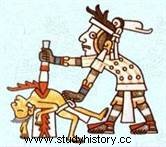
The Mexica people are not yet truly structured, not to say "civilized", and they are not well received by other groups in the region. After a difficult period, the Mexicas finally founded a capital, Tenochtitlan (Mexico City), in 1325. However, they remained under the threat (even the tutelage) of the Tezcoco cities, and especially Azcapotzalco (city of the Tepanecs). But the rivalry between these two radiant cities ended up serving the Mexicas:war broke out in 1418, Tezcoco was defeated and had to submit to the tepanec Tezozomoc. The Mexicas, allies of the latter, obtain a share of the tribute and a right of inspection over the defeated city.
The conflict nevertheless resumes after Tezozomoc's death. But this time, Tenochtitlan is allied with Tezcoco and another neighboring city, Tlacopan; it is the Triple Alliance. The goal, to crush Azcapotzalco, was achieved in 1428. The real winners, leaders of this alliance, were the Mexicas and we could then speak of the Aztec empire. Indeed, mainly with Moctezuma from 1440, the people of Tenochtitlan imposed their views on their allies (even if Tezcoco played a significant role) and began their conquest of Mesoamerica. Thus, from the 1480s, only a few cities remained, such as Tlaxcala or the Tarasque and Guerrero regions which resisted. The period also sees the use of the capture of inhabitants of cities outside the Triple Alliance for what is called "the flower war", which offers the Sun a significant number of sacrifices.
It is an "empire" in full power, yet stricken with doubt, that the Spaniards find upon their arrival in 1519. Indeed, the Mexicas interpret as signs ominous phenomena such as the appearance of a comet in 1509, and other tragic events such as the burning of the sanctuary of Toci, or different diseases and famines which lead to unrest. Moctezuma II is as if paralyzed by these prophecies, and the arrival of the conquistadores is seen in the same logic, perhaps explaining the attitude of the Mexica sovereign, which will lead to the fall of the empire...
The Incas
The 15th century is the birth of the Inca "empire". It is a small society centered around the city of Cuzco, in the Andes, which at the beginning of this century extends to the shores of Lake Titicaca. Their chief is then Viracocha Inca. Like the Aztecs with Tula, it would seem that the Incas felt linked to an ancestral civilization of this region, which occupied the city of Tiahuanaco around the tenth century.
The Incas, however, have rivals, the Chancas, who are mainly settled northwest of Cuzco. The war intervenes at the end of the 1430s, when the Chancas try to invade the territory of their neighbors, and lay siege to Cuzco defended by a son of Viracocha Inca, the future Pachacuti (“He who upsets the world”). The Chanca offensive was a resounding failure and, worse, the Inca counter-attack was radical:the enemy territory was invaded, its leaders executed. 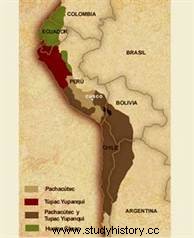
The beginning of the 16th century is in continuity, the Incas not knowing the troubles of the Mexicas. They continue to fortify their empire and expand into the Amazon. But the death of Huayna Capac in 1524 shows that the Inca power was ultimately more fragile than it seemed:troubles began that weakened the power and, on the eve of the conquest, the Inca empire was weakened.
Pre-Columbian civilizations:a connected continent?
This immense continent, with a large but irregularly dispersed population, with very different political systems but including at least two very powerful and structured "empires" (Aztecs and Incas), this continent so was he "connected"? Were there commercial or even diplomatic relations between all these spaces and these populations?
First of all, we know that the peoples of the Far North had contact with the peoples of Asia, via Bering, contacts visible through similar cultural practices. Within North America, it is around the great rivers that exchanges, essentially commercial, take place:along the Ohio, Tennessee and Mississippi there is a real trade, connecting the peoples of the South of this part from the Americas to those of the Northeast, up to the Iroquois. There are even traces of Mesoamerican and South American objects, indicating that the exchanges were continental. Mesoamerica is also very connected, including with the Caribbean, thanks to a cabotage trade and a road in the Yucatan linking the rivers in the interior. It is also known that the Maya had relations with the peoples of Panama.
And it was precisely in Panama that Pizarro learned of the existence in the South of a great empire, that of the Incas. Obviously, imperial policies favor these connections by their desire for expansion; we even have some legendary examples but which undoubtedly contain a part of reality, like these maritime voyages in the Pacific at the time of Tupac Yupanqui. This ocean is the setting for intense maritime traffic along present-day Peru, in cabotage and in connection with land merchant traffic. The rivers throughout the continent (from the Orinoco to the Amazon) are also strong vectors of connection.
Without falling into caricature on the decline of the continent in the 15th century, it should all the same be noted that on the eve of the conquest, the traffic and exchanges between all these spaces may seem less flourishing than in the classical period, whether in Mississippi or in Mesoamerica with the abandonment of the great Mayan cities. Moreover, there does not seem to have been any real contact between the two great empires, the Aztec and the Inca. However, the Americas that the Europeans were about to explore and then conquer were well developed and connected, and were not lost civilizations or completely "barbaric" compared to the conquistadors, as has often been asserted. And some peoples will resist for a very long time, like the Mapuches who will hold out...until the independence of Chile (1818)!
Bibliography
- P. Boucheron (dir), History of the world in the 15th century, Fayard, 2009.
- Eric Taladoire, Pre-Columbian civilizations, What do I know?, 2019
- E. Taladoire, B. Faugère-Kalfon, Pre-Columbian Archeology and Art:Mesoamerica, Ecole du Louvre, 1995.
- C. Bernand, S. Gruzinski, History of the New World volume 1:from discovery to conquest, Fayard, 2002.
